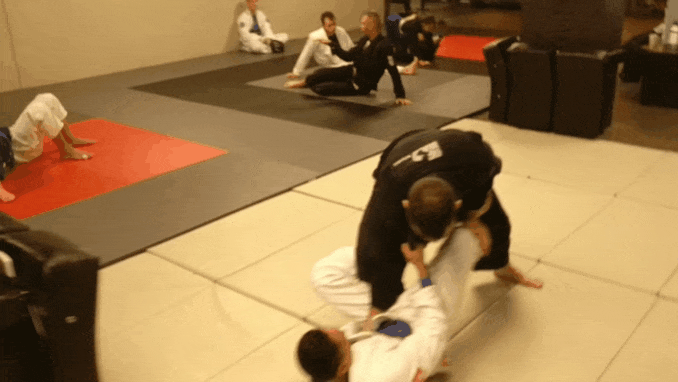Finally we are starting to look at open guard passing. Specifically, DLR. In order to pass we first need to make sure we are safe and address any immediate threats. In the case of DLR there are two major threats; the posting leg and the hooking leg. When I approach DLR my two biggest concerns are getting my back taken and being off balanced. The back take is threatened when the bottom player is able to turn the leg in with the hook and expose the back. Off balancing occurs when they can drive our weight to the far leg or can load our weight onto them and onto their hook. As a result when I approach DLR I look to do two things immediately, strip the post and compromise the hook. The order I do these things can vary, but I try to do both as soon as possible.
Stripping the hook Is simple, but not always easy. First we push our leg hard into the post to make sure we are getting pressure back. Then we grip the ankle with the same side hand. Once we feel comfortable with the pressure, we step back, shove the leg down and between our own legs and quickly step forward again.
To weaken the hook we want to limit it's ability to turn in our knee. Reaching the corresponding hand in to grip the ribs, hip, or belt establishes connection to the opponent. Placing our elbow inside our knee and flaring it out creates a solid structure much harder to collapse inward. What's more, it helps to offer balance. From here we are much safer, but still need to clear the hook to advance. We do this by dropping our head, picking our hip up as high as possible, and straightening our leg. Combined with outward pressure from the elbow the hook should pop off our leg. To ensure it doesn't immediately come back into place, we want to come back down into a squat with our heel off, butt sitting as close to our heel as possible. We want no space between our calf and hamstring.
The last thing I always recommend is to switch the ankle grip to a fabric grip around the knee. Using this grip and our knee on the opposite leg, we push the knees outward to find the end range of motion for the hip.
Our first pass option was the basic X pass. We have done most of the heavy lifting for this pass already. The only concern is if the bottom player still has a grip on our ankle. Frankly, most of the time if they are holding our actual leg, we can kick through it, but if they have a strong grip on the pants we may check down to the following two passes. In order to X pass we again drop our head and throw a strong donkey kick backward. The more you can get your shin horizontal the harder it will be to hold, the more vertical, the easier to hold. After back kicking, we collapse the former posting leg inside and punch it away, turning their hips. This crosses our arms in an x shape giving the pass it's name. Last we take two steps to finish in knee on belly.
We started with the X pass as our firs option because it is low risk and doesn't need us to change our grips. That said, sometimes we can't just kick through the grip and need another choice. One option is to knee cut instead. We keep our grips and shuffle both our feet to the side putting our opponent onto their inside hip. Our knee transfers from pinning one leg to the other. From here we turn our hip grip into an underhook and slide our knee to the mat. This will usually be enough to strip the pesky ankle grip. As always, we want prioritize getting underneath the near elbow.
The last pass we looked at was an over under. This could be our first choice or it may come up because the previous two have failed. If we tried to back kick and couldn't, then we tried to shuffle across and couldn't, the over under is a great choice. Step one is to take the hand gripping the hip and transfer that elbow back outside our knee. Next we take that hand back under their leg and find a fabric grip. This might be the belt, a lapel, or just a chunk of the gi. The goal is to have our shoulder take over the job of creating pressure against the thigh. We can do this safely because we are not putting our neck against the thigh, but our shoulder instead. We also still have a strong grip on the opposite knee negating the triangle. Using this grip the goal is to punch the leg straight and walk over the leg. Remember, don't try to jump up over a high knee, use your grips to lower the leg to a manageable position. We win the head to finish.








